5.23: Paleozoic Era
- Page ID
- 12099
\( \newcommand{\vecs}[1]{\overset { \scriptstyle \rightharpoonup} {\mathbf{#1}} } \)
\( \newcommand{\vecd}[1]{\overset{-\!-\!\rightharpoonup}{\vphantom{a}\smash {#1}}} \)
\( \newcommand{\dsum}{\displaystyle\sum\limits} \)
\( \newcommand{\dint}{\displaystyle\int\limits} \)
\( \newcommand{\dlim}{\displaystyle\lim\limits} \)
\( \newcommand{\id}{\mathrm{id}}\) \( \newcommand{\Span}{\mathrm{span}}\)
( \newcommand{\kernel}{\mathrm{null}\,}\) \( \newcommand{\range}{\mathrm{range}\,}\)
\( \newcommand{\RealPart}{\mathrm{Re}}\) \( \newcommand{\ImaginaryPart}{\mathrm{Im}}\)
\( \newcommand{\Argument}{\mathrm{Arg}}\) \( \newcommand{\norm}[1]{\| #1 \|}\)
\( \newcommand{\inner}[2]{\langle #1, #2 \rangle}\)
\( \newcommand{\Span}{\mathrm{span}}\)
\( \newcommand{\id}{\mathrm{id}}\)
\( \newcommand{\Span}{\mathrm{span}}\)
\( \newcommand{\kernel}{\mathrm{null}\,}\)
\( \newcommand{\range}{\mathrm{range}\,}\)
\( \newcommand{\RealPart}{\mathrm{Re}}\)
\( \newcommand{\ImaginaryPart}{\mathrm{Im}}\)
\( \newcommand{\Argument}{\mathrm{Arg}}\)
\( \newcommand{\norm}[1]{\| #1 \|}\)
\( \newcommand{\inner}[2]{\langle #1, #2 \rangle}\)
\( \newcommand{\Span}{\mathrm{span}}\) \( \newcommand{\AA}{\unicode[.8,0]{x212B}}\)
\( \newcommand{\vectorA}[1]{\vec{#1}} % arrow\)
\( \newcommand{\vectorAt}[1]{\vec{\text{#1}}} % arrow\)
\( \newcommand{\vectorB}[1]{\overset { \scriptstyle \rightharpoonup} {\mathbf{#1}} } \)
\( \newcommand{\vectorC}[1]{\textbf{#1}} \)
\( \newcommand{\vectorD}[1]{\overrightarrow{#1}} \)
\( \newcommand{\vectorDt}[1]{\overrightarrow{\text{#1}}} \)
\( \newcommand{\vectE}[1]{\overset{-\!-\!\rightharpoonup}{\vphantom{a}\smash{\mathbf {#1}}}} \)
\( \newcommand{\vecs}[1]{\overset { \scriptstyle \rightharpoonup} {\mathbf{#1}} } \)
\(\newcommand{\longvect}{\overrightarrow}\)
\( \newcommand{\vecd}[1]{\overset{-\!-\!\rightharpoonup}{\vphantom{a}\smash {#1}}} \)
\(\newcommand{\avec}{\mathbf a}\) \(\newcommand{\bvec}{\mathbf b}\) \(\newcommand{\cvec}{\mathbf c}\) \(\newcommand{\dvec}{\mathbf d}\) \(\newcommand{\dtil}{\widetilde{\mathbf d}}\) \(\newcommand{\evec}{\mathbf e}\) \(\newcommand{\fvec}{\mathbf f}\) \(\newcommand{\nvec}{\mathbf n}\) \(\newcommand{\pvec}{\mathbf p}\) \(\newcommand{\qvec}{\mathbf q}\) \(\newcommand{\svec}{\mathbf s}\) \(\newcommand{\tvec}{\mathbf t}\) \(\newcommand{\uvec}{\mathbf u}\) \(\newcommand{\vvec}{\mathbf v}\) \(\newcommand{\wvec}{\mathbf w}\) \(\newcommand{\xvec}{\mathbf x}\) \(\newcommand{\yvec}{\mathbf y}\) \(\newcommand{\zvec}{\mathbf z}\) \(\newcommand{\rvec}{\mathbf r}\) \(\newcommand{\mvec}{\mathbf m}\) \(\newcommand{\zerovec}{\mathbf 0}\) \(\newcommand{\onevec}{\mathbf 1}\) \(\newcommand{\real}{\mathbb R}\) \(\newcommand{\twovec}[2]{\left[\begin{array}{r}#1 \\ #2 \end{array}\right]}\) \(\newcommand{\ctwovec}[2]{\left[\begin{array}{c}#1 \\ #2 \end{array}\right]}\) \(\newcommand{\threevec}[3]{\left[\begin{array}{r}#1 \\ #2 \\ #3 \end{array}\right]}\) \(\newcommand{\cthreevec}[3]{\left[\begin{array}{c}#1 \\ #2 \\ #3 \end{array}\right]}\) \(\newcommand{\fourvec}[4]{\left[\begin{array}{r}#1 \\ #2 \\ #3 \\ #4 \end{array}\right]}\) \(\newcommand{\cfourvec}[4]{\left[\begin{array}{c}#1 \\ #2 \\ #3 \\ #4 \end{array}\right]}\) \(\newcommand{\fivevec}[5]{\left[\begin{array}{r}#1 \\ #2 \\ #3 \\ #4 \\ #5 \\ \end{array}\right]}\) \(\newcommand{\cfivevec}[5]{\left[\begin{array}{c}#1 \\ #2 \\ #3 \\ #4 \\ #5 \\ \end{array}\right]}\) \(\newcommand{\mattwo}[4]{\left[\begin{array}{rr}#1 \amp #2 \\ #3 \amp #4 \\ \end{array}\right]}\) \(\newcommand{\laspan}[1]{\text{Span}\{#1\}}\) \(\newcommand{\bcal}{\cal B}\) \(\newcommand{\ccal}{\cal C}\) \(\newcommand{\scal}{\cal S}\) \(\newcommand{\wcal}{\cal W}\) \(\newcommand{\ecal}{\cal E}\) \(\newcommand{\coords}[2]{\left\{#1\right\}_{#2}}\) \(\newcommand{\gray}[1]{\color{gray}{#1}}\) \(\newcommand{\lgray}[1]{\color{lightgray}{#1}}\) \(\newcommand{\rank}{\operatorname{rank}}\) \(\newcommand{\row}{\text{Row}}\) \(\newcommand{\col}{\text{Col}}\) \(\renewcommand{\row}{\text{Row}}\) \(\newcommand{\nul}{\text{Nul}}\) \(\newcommand{\var}{\text{Var}}\) \(\newcommand{\corr}{\text{corr}}\) \(\newcommand{\len}[1]{\left|#1\right|}\) \(\newcommand{\bbar}{\overline{\bvec}}\) \(\newcommand{\bhat}{\widehat{\bvec}}\) \(\newcommand{\bperp}{\bvec^\perp}\) \(\newcommand{\xhat}{\widehat{\xvec}}\) \(\newcommand{\vhat}{\widehat{\vvec}}\) \(\newcommand{\uhat}{\widehat{\uvec}}\) \(\newcommand{\what}{\widehat{\wvec}}\) \(\newcommand{\Sighat}{\widehat{\Sigma}}\) \(\newcommand{\lt}{<}\) \(\newcommand{\gt}{>}\) \(\newcommand{\amp}{&}\) \(\definecolor{fillinmathshade}{gray}{0.9}\)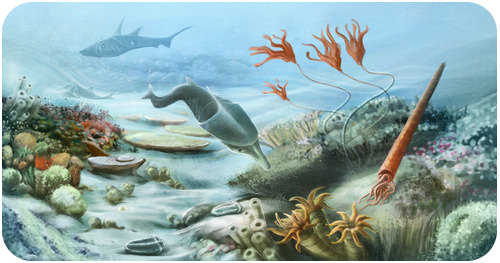
What was early life like?
Prehistoric underwater life exploded with amazing new creatures during the Paleozoic Era. Evolution allowed life to take many diverse forms, eventually developing the necessary adaptations to move from the ocean onto land.
Life During the Paleozoic
The Paleozoic Era is literally the era of “old life.” It lasted from 544 to 245 million years ago and is divided into six periods. Major events in each period of the Paleozoic Era are described in Figure below. The era began with a spectacular burst of new life. This is called the Cambrian explosion. The era ended with the biggest mass extinction the world had ever seen. This is known as the Permian extinction.
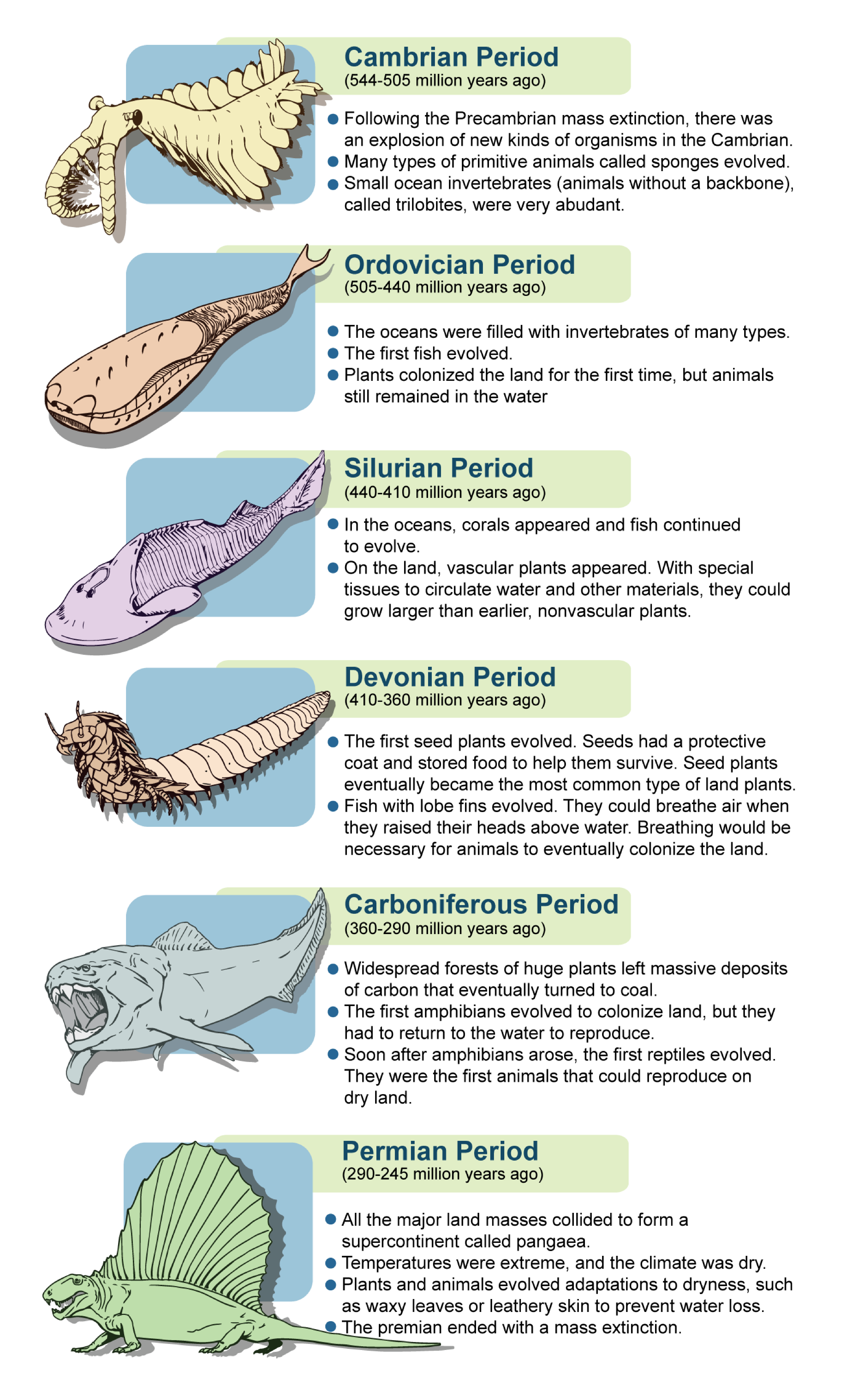 The paleozoic era includes the six periods described here.
The paleozoic era includes the six periods described here.The Paleozoic Era
The Cambrian Period: Following the Precambrian mass extinction, there was an explosion of new kinds of organisms in the Cambrian Period (544–505 million years ago). Many types of primitive animals called sponges evolved. Small ocean invertebrates called trilobites became abundant.
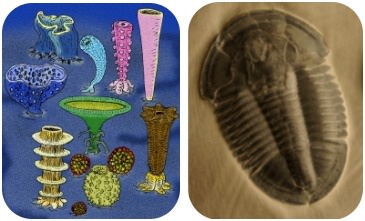 Two representatives of more than fifty modern animal phyla from the Cambrian explosion are reef-building sponges (left) and early arthropods known as trilobites (right). Both were abundant during the Cambrian and later became extinct; however, the phyla they represent persist to this day.
Two representatives of more than fifty modern animal phyla from the Cambrian explosion are reef-building sponges (left) and early arthropods known as trilobites (right). Both were abundant during the Cambrian and later became extinct; however, the phyla they represent persist to this day.The Ordovician Period: During the next period, the Ordovician Period (505–440 million years ago), the oceans became filled with invertebrates of many types. Also during this period, the first fish evolved and plants colonized the land for the first time. But animals still remained in the water.
The Silurian Period: During the Silurian Period (440–410 million years ago), corals appeared in the oceans, and fish continued to evolve. On land, vascular plants appeared. With special tissues to circulate water and other materials, these plants could grow larger than the earlier nonvascular plants.
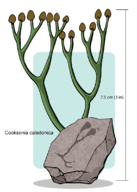 Cooksonia, a branching vascular plant with sporangia at the tips of each branch. Cooksonia fossils measure just centimeters in height and date from the Silurian period.
Cooksonia, a branching vascular plant with sporangia at the tips of each branch. Cooksonia fossils measure just centimeters in height and date from the Silurian period.The Devonian Period: During the Devonian Period (410–360 million years ago), the first seed plants evolved. Seeds have a protective coat and stored food to help these plants survive. Seed plants eventually became the most common type of land plants. In the oceans, fish with lobe fins evolved. They could breathe air when they raised their heads above water. Breathing would be necessary for animals to eventually colonize the land.
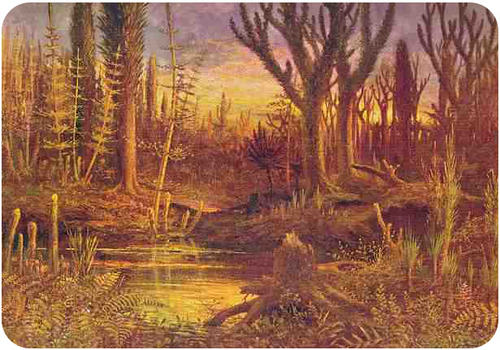 On land, club mosses, horsetails, and ferns joined primitive seed plants and early trees to form the first forests.
On land, club mosses, horsetails, and ferns joined primitive seed plants and early trees to form the first forests.The Carboniferous Period: Next, during the Carboniferous Period (360–290 million years ago), widespread forests of huge plants left massive deposits of carbon that eventually turned to coal. The first amphibians evolved to move out of the water and colonize land, but they had to return to the water to reproduce. Soon after amphibians arose, the first reptiles evolved. They were the first animals that could reproduce on dry land.
The Permian Period: During the Permian Period (290–245 million years ago), all the major land masses collided to form a supercontinent called Pangaea. Temperatures were extreme, and the climate was dry. Plants and animals evolved adaptations to dryness, such as waxy leaves or leathery skin to prevent water loss. The Permian Period ended with a mass extinction.
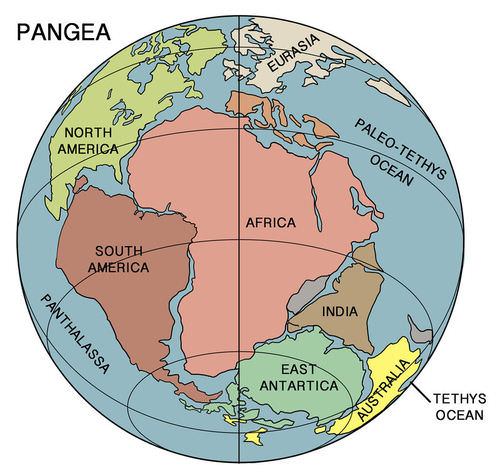 The supercontinent Pangaea encompassed all of today’s continents in a single land mass. This configuration limited shallow coastal areas which harbor marine species, and may have contributed to the dramatic event which ended the Permian - the most massive extinction ever recorded.
The supercontinent Pangaea encompassed all of today’s continents in a single land mass. This configuration limited shallow coastal areas which harbor marine species, and may have contributed to the dramatic event which ended the Permian - the most massive extinction ever recorded.In the mass extinction that ended the Permian, the majority of species went extinct. Many hypotheses have been offered to explain why this mass extinction occurred. These include huge meteorites striking Earth and enormous volcanoes spewing ashes and gases into the atmosphere. Both could have darkened the skies with dust for many months. This, in turn, would have shut down photosynthesis and cooled the planet.
Despite the great loss of life, there was light at the end of the tunnel. The Permian extinction paved the way for another burst of new life at the start of the following Mesozoic Era. This included the evolution of the dinosaurs.
Summary
- The Paleozoic Era began with the Cambrian explosion. It ended with the Permian extinction.
- During the era, invertebrate animals diversified in the oceans. Plants, amphibians, and reptiles also moved to the land.
Review
- What was the Cambrian explosion?
- What was the Permian extinction?
- List important evolutionary events that occurred during the Cambrian Period.
- List important evolutionary events that occurred during the Ordovician Period.
- List important evolutionary events that occurred during the Carboniferous Period.
- Describe Pangaea. When did Pangaea form?
| Image | Reference | Attributions |
 |
[Figure 1] | Credit: Christopher Auyeung, based on information from US Geological Survey Source: CK-12 Foundation License: CC BY-NC 3.0 |
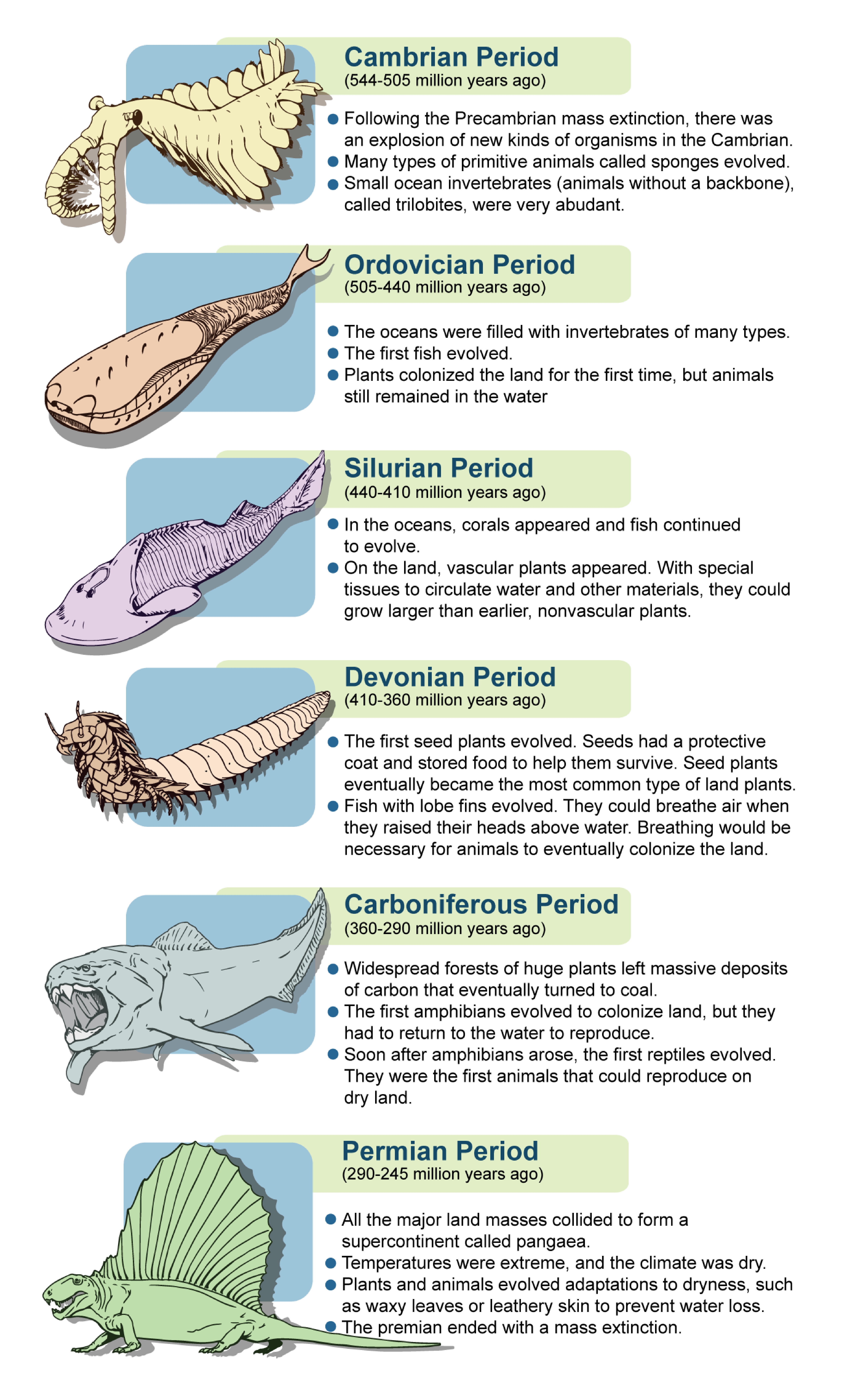 |
[Figure 2] | Credit: Mariana Ruiz Villarreal (LadyofHats) Source: CK-12 Foundation License: CC BY-NC 3.0 |
 |
[Figure 3] | Credit: Left: Stanton F. Fink; Right: User:TheoricienQuantique/Wikimedia Commons;By Martin R. Smith - Smith MR, Harvey THP, Butterfield NJ (2015) Data from: The macro- and microfossil record of the middle Cambrian priapulid Ottoia. Dryad Digital Repository. http://dx.doi.org/10.5061/dryad.km109, CC0, commons.wikimedia.org/w/inde...curid=40128882 Source: Left: commons.wikimedia.org/wiki/File:Archaeocyatha.jpg ; Right: commons.wikimedia.org/wiki/File:Asaphiscus_Wheeleri_3.jpg ; By Martin R. Smith - Smith MR ; Harvey THP ; Butterfield NJ (2015) Data from: The macro- and microfossil record of the middle Cambrian priapulid Ottoia. Dryad Digital Repository. http://dx.doi.org/10.5061/dryad.km109 ; CC0 ; commons.wikimedia.org/w/index.php?curid=40128882 License: Left CC BY 2.5; Right Public Domain |
 |
[Figure 4] | Credit: Mariana Ruiz Villarreal (LadyofHats) for CK-12 Foundation Source: CK-12 Foundation License: CC BY-NC 3.0 |
 |
[Figure 5] | Credit: Eduard Riou Source: commons.wikimedia.org/wiki/File:Devonianscene.jpg License: Public Domain |
 |
[Figure 6] | Credit: Laura Guerin Source: CK-12 Foundation License: CC BY-NC 3.0 |

